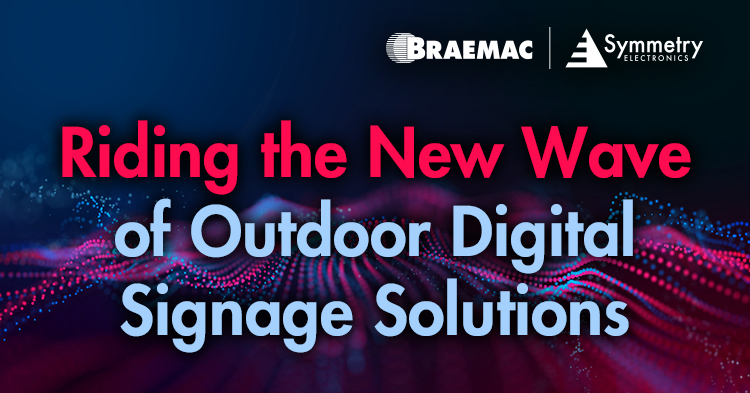- Home
- Braemac Blog
- Riding the New Wave of Outdoor Digital Signage Solutions
Riding the New Wave of Outdoor Digital Signage Solutions
About Jari Haiston

Since the beginning of billboards, outdoor digital signage has been a powerful way to attract and engage customers. Driven by ongoing technological developments and evolving customer expectations, the future of outdoor digital signage is experiencing significant advancements, innovations, and developments. It’s a versatile and powerful tool to convey information to a wide audience.
The era of basic billboards has given way to new, sophisticated displays that incorporate the latest innovations tech has to offer. If you’ve taken a stroll through somewhere like Times Square or Las Vegas Blvd. recently, you may have seen some of the many 3D billboards that now line the streets. Now more than ever, organizations are being compelled to embrace cutting-edge technology if they want to stand out from the crowd.
What is Outdoor Digital Signage?
The purpose of outdoor digital signage is to deliver dynamic and engaging content to a target audience in outdoor or public spaces. Outdoor displays are designed to withstand the elements and deliver high-quality images in any lighting condition. This technology utilizes electronic displays, such as LED or LCD screens, to showcase information, advertisements, or other multimedia content in various outdoor environments. It’s expected that the global outdoor digital signage market size will reach $14.31 billion by 2030.
The key purposes of outdoor digital signage include:
- Advertising and Marketing: Outdoor digital signage provides a platform for businesses to promote products, services, and brand messages to a broader audience in high-traffic areas.
- Information Dissemination: It serves as a tool for disseminating real-time information, news, weather updates, event schedules, and other relevant content to the public.
- Enhanced Communication: Outdoor digital signage enhances communication in public spaces, helping organizations and authorities convey important messages, alerts, or announcements effectively.
- Wayfinding and Navigation: It aids in guiding people through outdoor spaces, such as campuses, malls, and transportation hubs, by displaying maps, directions, and points of interest.
- Entertainment: Outdoor digital signage can be used for entertainment purposes, displaying engaging content such as videos, interactive games, and live streams to captivate the audience.
- Brand Visibility: Businesses use outdoor digital signage to increase their visibility and reinforce brand awareness, especially in high-visibility locations.
- Flexibility and Interactivity: Digital signage allows for real-time content updates and interactivity, enabling businesses and organizations to adapt their messages quickly and engage the audience more effectively.
- Revenue Generation: In some cases, outdoor digital signage can generate revenue through advertising partnerships or by promoting third-party content and events.
- Attracting Attention: The dynamic nature of digital displays makes them more attention-grabbing than traditional static signage, helping to capture the interest of passersby.
4 New Digital Displays of the Future
Almost as if out of a scene from The Jetsons’, the new wave of outdoor digital signage solutions are set to redefine public communications. The convergence of immersive technologies like augmented reality (AR) and virtual reality (VR) is set to transform static displays into immersive experiences. Imagine a world where passersby can interact with engineering models in 3D or explore complex structures through holographic projections.
1. 3D Digital Electronic Billboards
These are billboards that use advanced technology to create three-dimensional illusions that leap out at viewers. They can display hyper-realistic images, animations, or videos.
2. Interactive Kiosks
Interactive kiosks are touchscreen displays that offer various services, such as providing information, assisting wayfinding, or creating interactive engagements. They can also collect user feedback, data, or preferences, and tailor content accordingly.
3. Projection Mapping
This is a technique that projects images or videos onto irregular surfaces like buildings, walls, or sculptures. It can create stunning visual effects that transform the appearance and atmosphere of the environment.
4. Holographic Displays
Perhaps you’ve heard the buzz surrounding great performers ‘coming back to life’ in post-mortem holographic concerts. Elvis, Whitney Houston, and even Tupac have recently been brought back to life as holograms. This same concept is being applied in outdoor displays.
Holographic displays use light diffraction to create three-dimensional images that can be viewed without any special glasses or equipment. They can display realistic and interactive content that responds to the viewer’s position, gesture, or voice.




Next-Gen Tech Enabling Smart Displays Available at Braemac Americas
Successful smart display innovations are equipped with the latest AI, high-end computing, and cybersecurity solutions. Luckily, Braemac Americas|Symmetry Electronics has a wide portfolio of best-in-class products that elevate your digital signage design to the next level.
High-end computing solutions are essential for processing data generated by digital displays. The Genio 510 from Mediatek is an Edge-AI IoT platform that is ideal for smart retail applications. Developers are implementing it in next-gen digital display designs for its responsive edge processing, advanced multimedia, and multi-tasking operating system (OS). Supporting Wi-Fi 6, the Genio 510 features up to 8GB of quad-channel memory and an advanced VPU for visual AI.
Based on Mediatek Genio SoC solutions, VIA Technologies, Inc. has a comprehensive line of starter kits to streamline AIoT developments. Featuring integrated AI processors, VIA starter kits deliver 4K H.265/H.264 video processing, dual display and dual MIPI CSI-2 camera support, and optional 4G LTE mobile broadband for applications including voice edge processing, including facial recognition, object identification, motion tracking, OCR, and bio-metric measurement.







